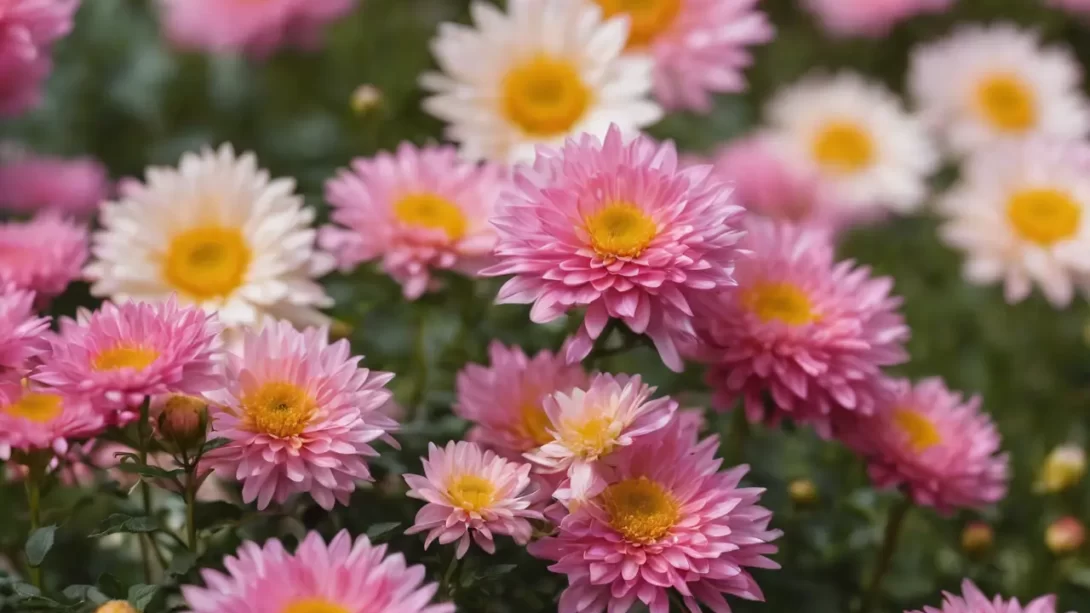Chrysanthemums, commonly known as mums, are a favorite for adding vibrant color to fall gardens. Renowned for their diverse colors and varieties, mums can keep blooming from late summer through fall, making them a staple in autumnal landscapes. To ensure these beautiful flowers reach their full potential, certain gardening practices are essential. This article will guide you through the key steps to keep your mums blooming vibrantly.
Mums
Mums come in two primary types: hardy and florist mums. Hardy mums are perennials that can withstand cold temperatures and return year after year. Florist mums, often sold as potted plants, are usually treated as annuals and are less tolerant of freezing conditions. Mums bloom in response to the shorter days and longer nights of late summer and early fall. Understanding your variety’s specific needs is crucial for its care and prolonged blooming.
Selecting the Right Variety
The key to a long-lasting mum display starts with selecting the right variety. Choose disease-resistant varieties for a healthier, more resilient plant. Hardy mums are generally a better choice for outdoor gardens as they bloom annually. Look for varieties that bloom at different times in the season to extend the overall blooming period of your garden. Local nurseries or gardening clubs can offer advice on the best varieties for your area.
Planting and Location
Proper planting and location are crucial for the health and longevity of mum blooms. Plant mums in a spot where they will receive at least six hours of direct sunlight daily. They thrive in well-draining soil, as standing water can lead to root rot. When planting, ensure the root ball is level with the soil surface and space the plants adequately to allow for air circulation. This helps prevent fungal diseases, which can hinder blooming.
Soil and Fertilization
Mums do best in well-draining soil rich in organic matter. Amend your garden soil with compost or other organic material to improve its quality and drainage. Fertilization plays a vital role in the growth and blooming of mums. Use a balanced, slow-release fertilizer at planting time and then switch to a high phosphorus fertilizer to encourage blooming as the flowering season approaches. Avoid over-fertilizing, as this can lead to lush foliage at the expense of blooms.
Watering Techniques
Watering is a critical aspect of mum care, especially to keep them blooming. Mums require a consistent supply of moisture but are susceptible to root rot if overwatered. Here’s how to water them effectively:
- Consistent Moisture: Ensure the soil remains evenly moist. During dry spells or in particularly hot climates, this may require watering every other day.
- Avoid Overwatering: Check the soil before watering. If the top inch of soil is dry, it’s time to water. Avoid watering if the soil feels damp to prevent waterlogging.
- Proper Technique: Water at the base of the plants to avoid wetting the foliage, as this can lead to fungal diseases.
Pinching and Pruning
Pinching back and pruning mums not only helps maintain their shape but also encourages more robust blooming. Here’s how to do it:
- Pinching Back: When new growth reaches 4-6 inches in spring and early summer, pinch off the top 1-2 inches of each stem. This encourages the plant to become bushier and produce more flowers.
- Pruning: If your mums have become leggy or overgrown, don’t hesitate to cut them back. This can rejuvenate the plant and lead to a flush of new growth and flowers.
Pest and Disease Management
Mums can be affected by pests and diseases, which can impede their blooming. Some common issues include aphids, spider mites, and powdery mildew. Here’s how to manage these problems:
- Regular Inspection: Check your mums regularly for signs of pests or disease. Early detection is key to effective treatment.
- Organic Solutions: Use insecticidal soaps or neem oil to control pests. For fungal diseases like powdery mildew, ensure good air circulation and consider using a fungicide.
- Chemical Control: In severe cases, a more potent pesticide or fungicide may be necessary. Always follow the product’s instructions and apply with caution.
Deadheading and Maintenance
Deadheading, or the removal of spent flowers, encourages mums to produce more blooms. Here’s how to deadhead and maintain your mums:
- Deadheading Process: Snip off the faded blooms at the stem just below the flower head. This prevents the plant from expending energy on seed production and redirects it to new blooms.
- Regular Maintenance: Apart from deadheading, remove any yellowing or dead leaves to keep the plant healthy and attractive. This also helps in preventing disease.
Regular maintenance, coupled with strategic pinching and pruning, ensures that your mums will continue to produce vibrant blooms throughout the season. Stay attentive to their needs, and these gorgeous flowers will reward you with a spectacular fall display.
Preparing for Winter
For gardeners in colder climates, preparing mums for winter is crucial to ensure their return the following year. Hardy varieties of mums have a better chance of surviving the winter, but they still require some care:
- Stop Fertilizing: Cease fertilization by late summer to prevent new growth that won’t survive the winter.
- Mulching: After the first hard frost, apply a thick layer of mulch over the mums. This insulates the roots and protects them from fluctuating temperatures.
- Pruning: It’s often recommended to leave the dead foliage in place during winter to provide additional protection. Prune back the dead stems in early spring to make way for new growth.
Conclusion
Keeping mums blooming requires a combination of proper planting, consistent care, and attention to the plant’s needs throughout its growth cycle. By selecting the right varieties, providing adequate sunlight and water, and implementing regular maintenance practices like pinching, pruning, and deadheading, you can enjoy vibrant mum blooms from late summer into fall. Remember, the key to a flourishing mum display is not just in the immediate care but also in preparing these beautiful plants for the harsher months, ensuring their beauty for seasons to come. With patience and dedication, mums can be one of the most rewarding additions to your autumn garden.




